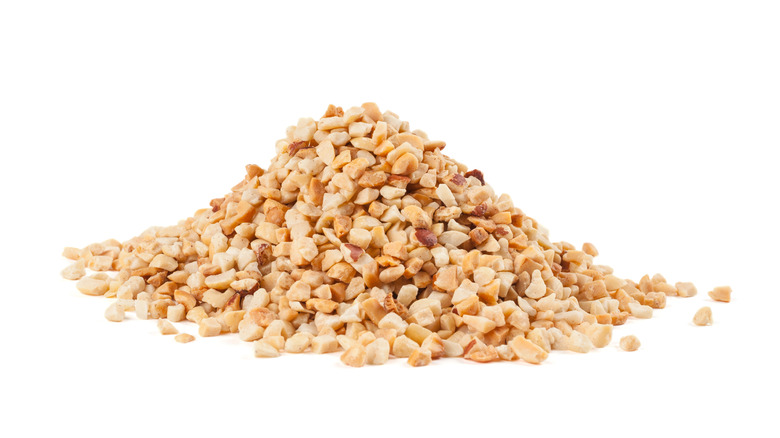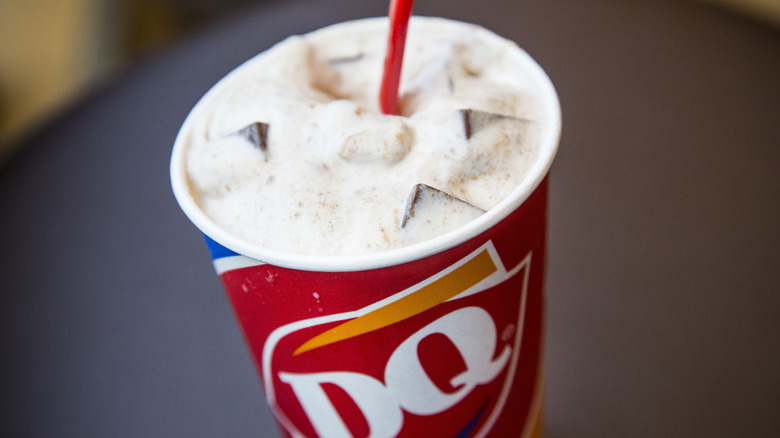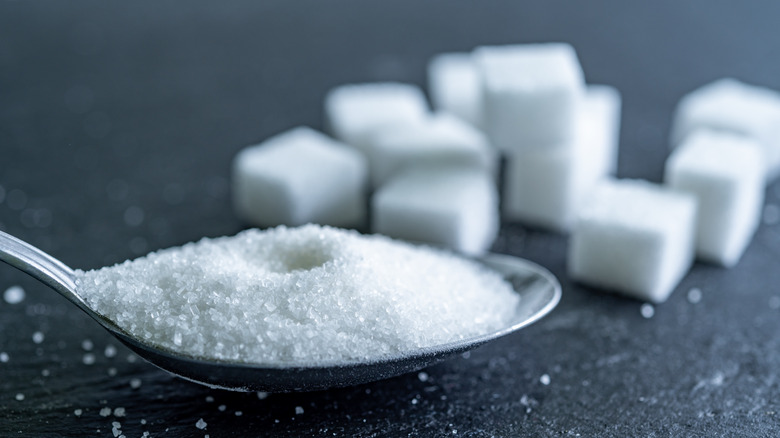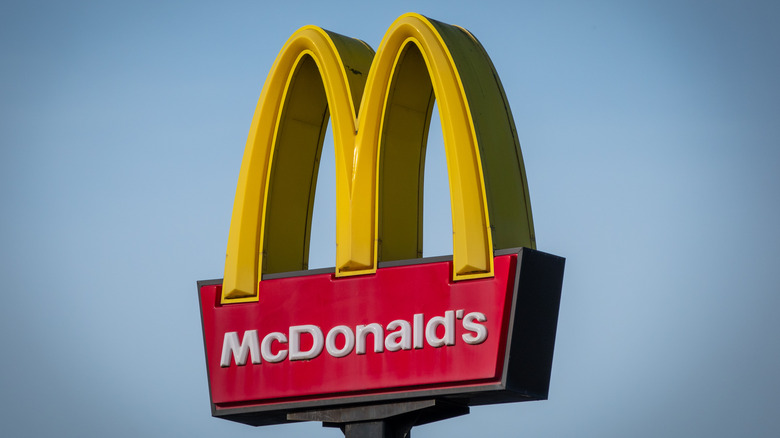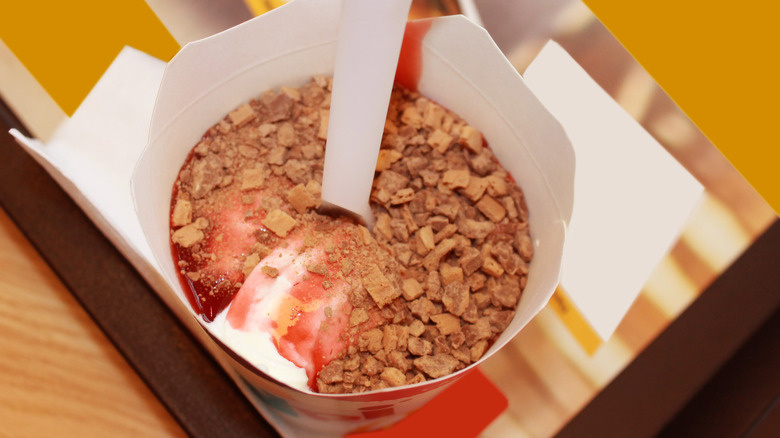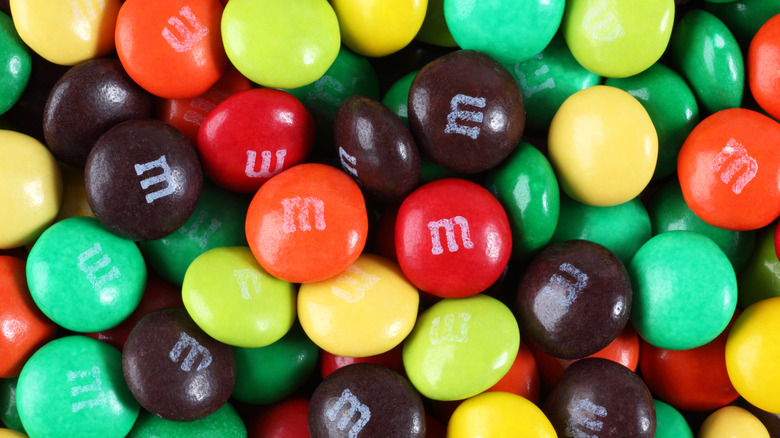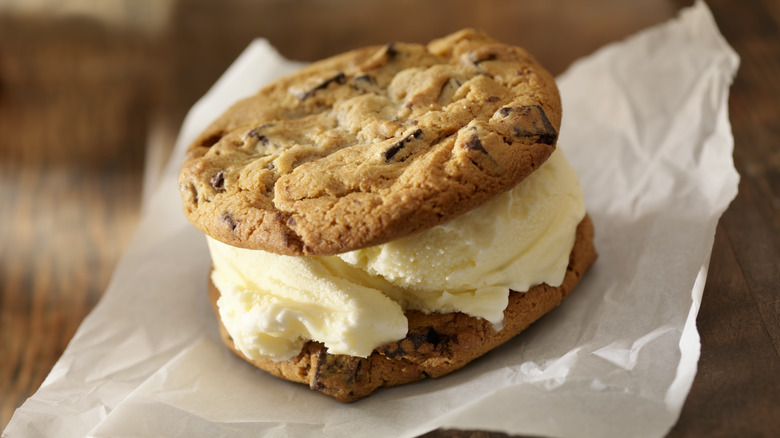What You Need To Know Before Ordering Fast Food Ice Cream
If you're anything like us, a fast food meal just isn't complete without something sweet at the end — and more often than not, that sweetness comes in the form of ice cream. Ice cream has a surprisingly ancient history, having been around in some form for thousands of years, but it only really hit the mainstream in America in the late 19th century, and the invention of soft serve in the early 1900s kicked things up a notch. Suddenly, ordering ice cream became a standard part of a trip to a fast food restaurant, and that hasn't changed to this day.
Despite it being around for all our lives, though, there are still a few question marks around fast food ice cream and the info we probably should know when we're ordering it. Most people don't even know what's inside the cone or tub they're buying, and certain facts about soft serve's nutritional value or additives may cause some to think twice. There are also a host of ice cream hacks you could be performing with your order that you've overlooked, but you'll want to be aware of. Well, never fear, folks, we've got your Dairy Queen, Burger King, and McDonald's ice cream questions answered right here.
Your ice cream may not, in fact, be ice cream
One of the most curious things about ordering fast food ice cream is that you might not be getting ice cream in the first place. Well, not in an official sense, anyway. To call a frozen product "ice cream," at least ten percent of it has to be milkfat. When it comes to soft serve from certain fast food restaurants, like Dairy Queen, they often don't contain this amount, and have something closer to five percent. This prevents them from being considered true ice cream, being classified instead as a "reduced-fat" version.
So why does soft serve usually have such a low fat content? It's all down to consistency. When the fat content is too high, soft serves become far too heavy to pull through a machine and eat easily. There are soft serve mixes out there that have a higher fat level, but these are generally pretty rare in fast food settings. You've got to wonder whether this is why loads of fast food chains have snappy names for their frozen dessert products, like McFlurry or Blizzard. After all, it's much cooler than calling it "reduced-fat ice cream," right?
You should be mindful of allergens
Anyone who has a food allergy will know how important it is to be careful with what you order — and with fast food ice cream, that's no different. Because of the fast-paced nature of fast food kitchens, there's a risk of unintentional cross-contamination during busy service periods, which isn't helped by the fact that some fast food restaurants include well-known allergens in their items. This was most clearly shown in 2017, when McDonald's Canada decided to offer the SKOR McFlurry, which contained chopped almonds. This presented a clear risk to people with nut allergies, which McDonald's acknowledged on its website, and despite outrage from customers they continue to offer the item to this day.
If you're worried you'll have to give up your fast food ice cream fix forever, though, there's no need to never have it again. A pilot study conducted by Clemson University examined the risk of cross-contamination in ice cream scoop shop dipper wells. It found that generally speaking, ice cream shops don't present a big risk to folks with allergens. This came with a few important caveats, though, and the study advised that ice cream shops should follow stringent cleaning practices and signpost their allergens more clearly. If you're ever in doubt, it's always better to communicate your allergy to the staff in a fast food restaurant, or else avoid ordering from there entirely.
Certain fast food ice creams contain a troublesome ingredient
You can have your pick of the ultimate ice cream brands, but for some people, soft serve still hits the spot better. How does it get its smooth, pourable consistency, though? That's down to the help of some additives — and one of them, carrageenan, is a little tricky. Carrageenan is a key ingredient in the Vanilla Cone from McDonald's, which also contains guar gum and cellulose gum. These additives are included for their textural and stabilizing benefits, and help to give the McDonald's soft serve its serious swirl. It's carrageenan that worries us the most, though, due to its potential health effects and risk of causing inflammation.
Carrageenan has been found in studies to prompt signs of inflammatory bowel disease (or IBD) in animal trials, per a review published in Frontiers in Pediatrics. While the effect of this additive (which is derived from seaweed) on humans is still less clear, due to less evidence being available of its impact at this point, the review does point out that there appears to be a correlation between higher carrageenan consumption and higher rates of IBD. If you're concerned about consuming carrageenan, it's always a good idea to check the website of the fast food restaurant you're planning on going to, to see if they have the nutritional information and ingredients listed online.
Not all soft serve tastes the same
Everyone knows that general soft serve taste: Creamy, sugary, and full of vanilla or chocolate. Did you know, though, that soft serve can vary pretty significantly in terms of its flavor, depending on where you're ordering from? Because soft serve mixes often have different formulations, the cones they produce can be pretty different, with some having a more natural and delicate taste, and others tasting like they're full of chemicals.
While these varying flavors can be pretty subtle, to the discerning palette the differences are quite evident — and this is reflected in small differences in ingredient lists. At McDonald's, for example, cream is the third-listed ingredient in its Vanilla Soft Serve, which is probably why it has a slightly more mellow, luscious flavor. By contrast, there's no cream to be seen at all in Dairy Queen's Vanilla Cone, and nor is it present in Burger King's Soft Serve Mix, which instead uses sweet whey to flavor its dessert and add texture. Naturally, figuring out your favorite will take a bit of trial and error; but hey, it's a good excuse to try them all, right?
Some fast food ice creams are less nutritious than others
Ice cream generally isn't one of those fast food items that cause controversy, but it's far from innocent. The sweet treat is often crammed full of ingredients like sugar and corn syrup, alongside a host of pretty intense-sounding additives. However, not all of them are made the same nutritionally. Some, like Dairy Queen's Royal Ultimate Choco Brownie Blizzard With Fudge, are jaw-droppingly unhealthy. Registered dietitian Jessie Hulsey explained to Eat This, Not That, "This decadent treat packs a whopping amount of calories, with a large serving containing approximately 1,340 calories and 60 grams of fat. This Blizzard is loaded with added sugars, providing around 148 grams per large serving."
Others, like the classic Vanilla Cone from McDonald's, may surprise you with how relatively wholesome they are. Although the McDonald's cone isn't exactly chock-full of vitamins and minerals, it does contain a pleasing 15% of your daily calcium intake, as well as five grams of protein. Smaller options from Dairy Queen, like the Hot Fudge Sundae, also pack in a surprising amount of protein. If in doubt, ask for the nutritional information.
The ice cream machines may not be cleaned very often
There's nothing quite like the fear of ordering from a fast food restaurant that doesn't seem to have its sanitation on point. Unfortunately, this concern can be well-founded when it comes to ice cream. Soft serve machines in some fast food joints may fall short of cleaning standards, and when you combine owners cutting corners, this can lead to some unpleasant results. "I was a shift supervisor at a fast food place and years later, I still refuse to eat anything with ice cream in it," revealed one ex-worker, via Reddit. "The machine we had was always covered in mold and spoiled cream while the owner's "fix" was to scrape off a layer of mold and spray some Clorox on it."
This lack of cleaning can be seriously dangerous. In 2023, outbreaks of Listeria were reported in Tacoma and Brooklyn, and both were attributed to fast food ice cream. Both resulted in hospitalizations, and in the case of the Tacoma outbreak, three people died. The outbreak in Tacoma was linked to an unsanitary ice cream machine, where Listeria was found. It can take a lot of bravery to call out a restaurant you're in on their sanitation, but if you have any uncertainty at all, it's far wiser to not eat the food you're given, and even consider contacting local authorities about the cleanliness of the establishment.
Ice cream machines can house some unwanted critters
It's not unreasonable to want your fast food restaurant's ice cream machine to just contain ... well ... ice cream. Regrettably, that's not always what you get. An ex-McDonald's employee brought this into pretty clear focus when they detailed what happened when a sister store got in touch, asking if their store had any complaints about their shakes, presumably to check whether their premade mix was safe. The ex-employee revealed on Reddit, "Turns out a mouse had died in the machine at some point and had been chewed up by the internal mixer... Yeah, I don't get shakes from there anymore and I eye the ice cream especially hard." Gross.
It's not just rodents that get into these machines, either. An ex-worker at Sonic cautioned on Reddit, "I worked at one location that just about never cleaned the machine out." Talking about their former employee's ice cream machine, they explained, "We added new milk into the old milk over and over without first dumping the old milk out. At the end of the summer we found mold and a dead fly in the milk tray." For balance, though, it's worth pointing out that a study published by Restaurantware found that fast food restaurants are generally vastly cleaner than five-star eateries, and fast food places usually have super-stringent cleaning routines. Unless you're in the kitchen, though, you never quite know.
More often than not, the machine isn't broken — it's cleaning itself
"The machine's broken" is a common refrain heard in McDonald's restaurants across the land — so much so that people have even resorted to apps that tell you if the McFlurry machine is working. Interestingly, though, the employees may just be using this as a cover when their machines go through their lengthy cleaning process. McDonald's uses ice cream machines from The Taylor Company in a large number of its stores, and the model used in its restaurants takes roughly four hours to clean itself, a process that needs to be done daily. Normally, this is done overnight, but the machine frequently decides that it needs to redo the cleaning in the morning or part-way through the shift, not alerting the user as to why.
In other situations, employees may simply forget to start the cleaning cycle the night before, leaving the person on shift the next day to allow it to clean itself. In some cases, these machines' reliability around their self-cleaning function got so bad that franchisees started using a third-party device made by a company called Kytch to fix their units. This, however, triggered drama between the two companies and an attempt to prevent franchisees from using these devices at McDonald's.
If you order soft serve, you may be mostly getting air
If you've ever wondered why fast food ice cream is so light and airy, here's the secret: It's 'cos of air. Lots of it. Soft serve is highly aerated, and usually contains somewhere between 30% to 60% air, depending on how it's churned. This air gives it way more volume and makes it look more impressive when piled into your cone.
Wait a few minutes, though, and you'll likely see that volume rapidly reduce. As the ice cream melts, the air inside it will dissipate, and you'll end up with way less than it looked beforehand. This also means that while it can look filling to begin with, you might find that soft serve is a lot less satisfying than you might think. Regular ice cream can also have a surprising amount of air, even if it's being scooped instead of poured — the way to tell is to compare the volume of your ice cream when frozen to when it's melted. If you're ordering gelato, though, you're in luck. Because this Italian ice cream is churned more slowly than other kinds, it has less air and therefore more cold, hard, frozen deliciousness.
Fast food ice creams can have an impact on heart health
There's no getting around the fact that fast food ice creams are full of sugar. When ordering it, though, one thing you should keep in mind is how much that sugar could be affecting your health long-term, by causing a blood sugar spike which can impact your cardiovascular health.
This is particularly important, considering most of the time, you'll have already eaten a full meal. "Any dessert that causes an abrupt spike in blood sugar that is already climbing to an elevated altitude after the fast food meal is to be cautioned," stresses cardiologist Nitin Bhatnagar, per She Finds. Bhatnagar points out that regularly consuming these kinds of treats, which are also often high in salt, can cause a snowballing effect on your heart health, and heighten the risk of high blood pressure and high cholesterol. Naturally, too, the higher your fast food ice cream is in sugar, sodium, and saturated fat, the more it will impact your health.
Your mix-ins can make a big difference
Mix-ins are a key part of many people's ice cream orders, but they can vary significantly in how much they change your ice cream's nutritional value. In fast food restaurants, mix-ins are prepackaged candies and are usually fairly lacking in the vitamins, minerals, or fiber that you'd gain by adding fresh fruit to your ice cream. These candies are usually pretty high in sugar, and in some cases, they can add dozens of grams to your dessert.
This becomes clear when you compare two different McFlurry flavors. A Regular McFlurry with M&M's has a total of 69 grams of added sugar, 137% of the daily value recommended by the FDA. This sugar amount contributes significantly to its 640 calories. A Regular McFlurry with Oreo Cookies, on the other hand, has 48 grams of added sugar. While this is still a high amount, it's more than 20 grams less than the other option. These two examples illustrate how a simple choice can make a big impact on your overall daily nutritional intake, which can add up to big long-term results.
You can easily hack your fast food ice cream order
One of the most disappointing things about ordering fast food ice cream is feeling like you need to stick to the rulebook. Well, folks, you don't. There are loads of ways to hack your ice cream order to make brand-new concoctions or revive old menu items. At DQ, for example, the now-discontinued Cookie Jar Blizzard can be created, by ordering a normal Blizzard and adding hot fudge, Oreos, and cookie dough. In just a few seconds, you've got a classic offering, rich in chocolatey flavors.
@dqstrongsville #strongsville #strongsvilleohio #ohio #dairyqueen #dq #strongsvilledq #icecream #blizzard
Fans of menu hacks at McDonald's and Chick-fil-A will also want to try out their secret ice cream sandwiches. At the former, skip the chicken and grab a cup of vanilla ice cream with two chocolate chunk cookies on the side. Then, scoop the ice cream onto one of the cookies, sandwich the other one on top, and dig in. At McDonald's, order a McFlurry a McFlurry (or a regular Vanilla Cone with an extra spoon) and two chocolate chip cookies and combine the three items for dessert heaven.


